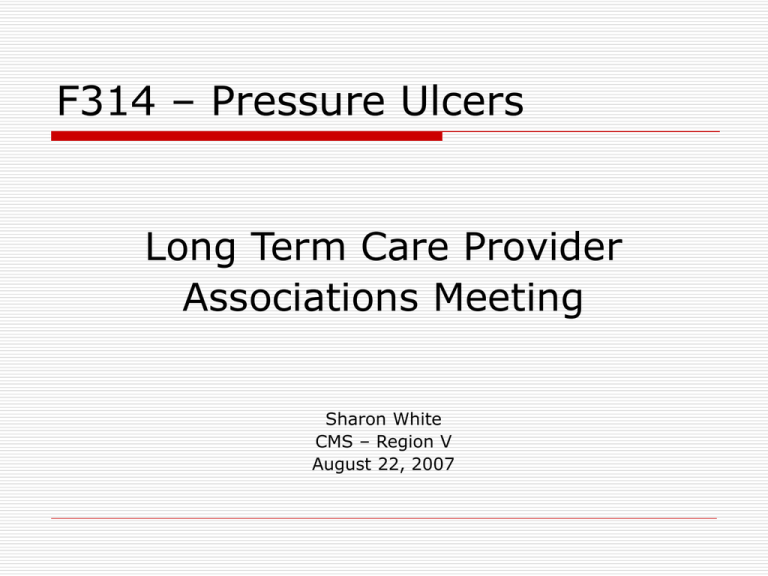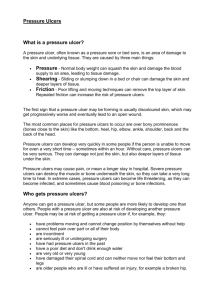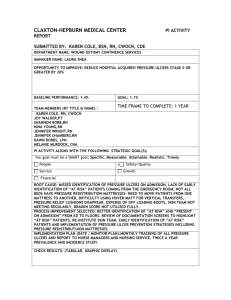F314 – Pressure Ulcers
advertisement

F314 – Pressure Ulcers Long Term Care Provider Associations Meeting Sharon White CMS – Region V August 22, 2007 F314 483.25(c) Pressure Sores Regulatory Requirement: Based on the comprehensive Assessment of a resident, the facility must ensure that 1) A resident who enters the facility without pressure sores does not develop pressure sores unless the individual’s clinical condition demonstrates that they were unavoidable; and 2) A resident having pressure sores receives necessary treatment and services to promote healing, prevent infection and prevent new sores from developing. Reasons to Prevent Pressure Ulcers Increased morbidity and mortality Increased infection rates Debilitation Pain Increased cost Additional medications Increased staff time to provide appropriate care necessary to heal the ulcer So what’s being done? National initiatives Advancing Excellence Campaign National Pressure Ulcer Advisory Panel GPRA Individual facility efforts CMS Regional and State Survey Agency efforts Provider Responsibility for Providing Adequate Care Commitment to high quality pressure ulcer management that permeates all aspects of the facility’s operation Instituting a prevention program based on accepted clinical guidelines for “at risk” residents Use of Quality Measures to develop and implement systems for pressure ulcer reduction Provider Responsibility for Providing Adequate Care Thorough knowledge of the federal requirements in order to comply with the regulations and ultimately to provide for the health and safety of residents Understanding of the survey process in helping providers evaluate the quality of care delivered and target quality improvement efforts Role of RO V and the SSA in the Reduction of Pressure Ulcers Investigate and evaluate the systems and processes for prevention and treatment of pressure ulcers in certified facilities Consistent and strict enforcement of CMS policies and regulations An Effective “System” would include: Prevention Assessment Identification Intervention Monitoring Evaluation Treatment “Ownership” Assessment Skin assessments are the first line of defense to prevent pressure ulcers from developing and to ensure effective treatment It is important for clinical staff to regularly conduct thorough skin assessments on each resident who is at risk for developing pressure ulcers Assessment A comprehensive assessment should address factors that have been identified as having an impact on the development, treatment and/or healing of pressure ulcers, which include: Risk factors Pressure points Nutrition Hydration Skin moisture, and Impact of moisture on skin Assessment A comprehensive assessment should include an evaluation of the skin integrity and tissue tolerance after pressure to the skin has been reduced or redistributed Deficiency Determination in the Absence of Pressure Ulcers A facility may have non-compliance with F314 without actual development of pressure ulcers by failing to: Accurately or consistently assess a resident’s skin integrity Identify a resident at risk of developing a pressure ulcer Identify and address risk factors Deficiency Determination in the Absence of Pressure Ulcers Implement preventive interventions in accordance with the resident’s need and current standards of practice Provide clinical justification for the unavoidable development or nonhealing/delayed healing or deterioration of a pressure ulcer Implement appropriate interventions for existing wounds to minimize infection and promote healing Deficiency Determination in the Absence of Pressure Ulcers Notify the physician of the resident’s condition or changes in the resident’s wound Adequately implement pertinent infection management practices in relation to wound care Identify and/or know how to apply relevant policies and procedures for pressure ulcer prevention and treatment Deficiency Determination – “Avoidable vs. Unavoidable” Was preventive care -aggressive? -consistent? -appropriate? -resident specific? If not, the development of a pressure ulcer may have been “avoidable.” Clarification “Avoidable vs. Unavoidable” The presence of any one, or even several, risk factors or conditions does NOT make a pressure ulcer “Unavoidable” Scope and Severity Level 4 Stage IV (development or non-healing) Stage III (infected locally/systemically) Extensive failure in multiple areas of care Level 3 Stage III Recurrent or multiple Stage II’s Facility failure to consistently implement care plan -> increase size, failure to heal, untreated pain Scope and Severity Level 2 Stage I Stage II receiving appropriate treatment Failure to implement portion of care plan independent of healing Level 1 – Eliminated Region V’s Plan Standard surveys: Federal and state surveyors review QM/QI Reports and CMS672 with the facility to ensure that pressure ulcers have been reported accurately FOSS surveys: Federal surveyors pay strict attention to how well SA surveyors evaluate the nursing home’s performance as it relates to pressure ulcers. When identified as a concern, specific mention will be recorded in Measures 1,2,3 and 6 of the FOSS report. Region V’s Plan Beginning calendar year 2007, Region V is warning facilities with non-compliance at F314, S/S level F or higher, that continuing non-compliance will result in the imposition of more severe remedies. Future cycles of non-compliance will result in the imposition of more robust and possibly more diverse remedies Region V’s Plan More severe remedies include: Optional Denial of Payment, higher Civil Money Penalty amounts, Directed Inservice Training, Discretionary Termination Each case will be evaluated independently to determine which remedies will be most effective in promoting prompt and permanent correction of the deficiencies Consistency is the key to effective prevention






